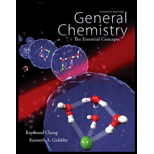
Concept explainers
(a)
Interpretation:
Need to write the half-cell reaction for molten barium chloride (BaCl2) and find the number of grams of barium metal produced.
Concept introduction:
Barium chloride melts at 1193K and conductivity increases with several orders. This process was carried in a setup called downs cell. Further Ba2+ get reduced by getting two electrons from cathode.
By calculating the total number of charges that flow through the circuit, the amount of barium deposited on the electrode can be calculated in successive steps. Since coulomb is the amount of electric charge flowing in a circuit in 1s, when current is 1A. So the above statement can be represented by the following equation.
On dividing the number of charges with Faraday constant we can get the number of moles of electron
From knowing the number of mole of electrons and using the stoichiometry of the reaction, the number of moles of the substance reduced or oxidized can be determined. This can be explained by the representative reaction as shown below.
2 mole of electrons was needed for the reduction of one mole of barium. so the number of moles of barium reduced can be calculated by the following equation.
(b)
Interpretation:
Need to write the half-cell reaction for molten barium chloride (BaCl2) and find the number of grams of barium metal produced.
Concept introduction:
Barium chloride melts at 1193K and conductivity increases with several orders. This process was carried in a setup called downs cell. Further Ba2+ get reduced by getting two electrons from cathode.
By calculating the total number of charges that flow through the circuit, the amount of barium deposited on the electrode can be calculated in successive steps. Since coulomb is the amount of electric charge flowing in a circuit in 1s, when current is 1A. So the above statement can be represented by the following equation.
On dividing the number of charges with Faraday constant we can get the number of moles of electron
From knowing the number of mole of electrons and using the stoichiometry of the reaction, the number of moles of the substance reduced or oxidized can be determined. This can be explained by the representative reaction as shown below.
2 mole of electrons was needed for the reduction of one mole of barium. so the number of moles of barium reduced can be calculated by the following equation.
Want to see the full answer?
Check out a sample textbook solution
Chapter 19 Solutions
Package: General Chemistry with Connect 2-year Access Card
 ChemistryChemistryISBN:9781305957404Author:Steven S. Zumdahl, Susan A. Zumdahl, Donald J. DeCostePublisher:Cengage Learning
ChemistryChemistryISBN:9781305957404Author:Steven S. Zumdahl, Susan A. Zumdahl, Donald J. DeCostePublisher:Cengage Learning ChemistryChemistryISBN:9781259911156Author:Raymond Chang Dr., Jason Overby ProfessorPublisher:McGraw-Hill Education
ChemistryChemistryISBN:9781259911156Author:Raymond Chang Dr., Jason Overby ProfessorPublisher:McGraw-Hill Education Principles of Instrumental AnalysisChemistryISBN:9781305577213Author:Douglas A. Skoog, F. James Holler, Stanley R. CrouchPublisher:Cengage Learning
Principles of Instrumental AnalysisChemistryISBN:9781305577213Author:Douglas A. Skoog, F. James Holler, Stanley R. CrouchPublisher:Cengage Learning Organic ChemistryChemistryISBN:9780078021558Author:Janice Gorzynski Smith Dr.Publisher:McGraw-Hill Education
Organic ChemistryChemistryISBN:9780078021558Author:Janice Gorzynski Smith Dr.Publisher:McGraw-Hill Education Chemistry: Principles and ReactionsChemistryISBN:9781305079373Author:William L. Masterton, Cecile N. HurleyPublisher:Cengage Learning
Chemistry: Principles and ReactionsChemistryISBN:9781305079373Author:William L. Masterton, Cecile N. HurleyPublisher:Cengage Learning Elementary Principles of Chemical Processes, Bind...ChemistryISBN:9781118431221Author:Richard M. Felder, Ronald W. Rousseau, Lisa G. BullardPublisher:WILEY
Elementary Principles of Chemical Processes, Bind...ChemistryISBN:9781118431221Author:Richard M. Felder, Ronald W. Rousseau, Lisa G. BullardPublisher:WILEY





